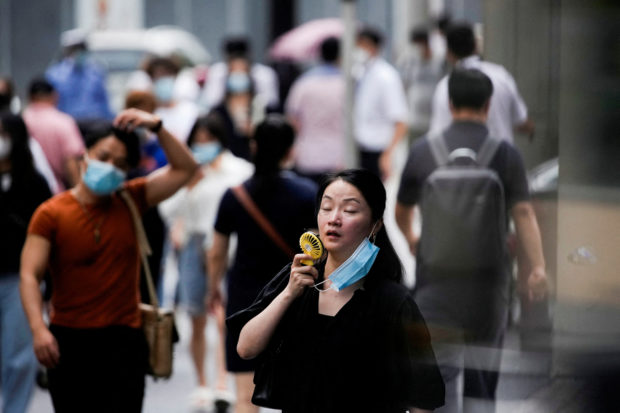China’s Xinjiang warns of more floods, risk to cotton crop amid heatwaves

A woman wearing face mask uses a fan as she walks on a street on a hot day, following the coronavirus disease (COVID-19) outbreak in Shanghai, China July 19, 2022. REUTERS FILE PHOTO
SHANGHAI — China’s Xinjiang province on Saturday warned of more flash floods and mudslides and risks to agriculture as heatwaves swept across the region, accelerating the pace of glacial melt and posing hazards for its cotton production.
China has been baked by above-normal summer heat since June, with some meteorologists blaming climate change. The excessively hot weather has driven up demand for electricity to cool homes, offices and factories. In agricultural regions, drought has been a concern.
Xinjiang’s latest heatwaves have been particularly long lasting and widespread, Chen Chunyan, chief expert at the Xinjiang Meteorological Observatory, told state media.
She said the extreme weather in the south and east of the region, more than twice the size of France, has already lasted for about 10 days.
Xinjiang’s meteorological bureau renewed its red alert for the region – the highest in a three-tier heat warning system – on Saturday, forecasting temperatures in Kashgar, Hotan, Aksu, and Bazhou could exceed 40 degrees Celsius (104 degrees Fahrenheit) over the next 24 hours.
Article continues after this advertisement“Continued high temperature has accelerated glacial melting in mountainous areas, and caused natural disasters such as flash floods, mudslides, and landslides in many places,” Chen said.
Article continues after this advertisementThe China Meteorological Administration said a day earlier that the glacial melting in Xinjiang poses a high risk of dam failure on a tributary of the Aksu River near China’s border with Kyrgyzstan.
Mostly known for its deserts, Xinjiang is also home to long mountain ranges along its borders, including the Tian Shan mountains, the Pamirs, the Kunlun mountains and the Karakoram, which have become increasingly popular for Chinese tourists amid COVID-19 restrictions on international travel.
Temperatures in the oasis city of Turpan hit 45.8C at 5 p.m. (0900 GMT).
Such heatwaves could also impact crops, especially cotton, Chen said.
Xinjiang accounts for production of about 20% of the world’s cotton, a water-thirsty crop.
The latest round of extreme temperatures has affected some 20 provinces. As of 5 p.m., 84 red alerts were in force across China, mostly in Xinjiang and the manufacturing provinces of Zhejiang and Fujian.
Temperatures in the city of Taizhou, in Zhejiang, hit an all-time high of 43C on Saturday.
“The hot and sunny weather is expected to continue tomorrow (Sunday) and the day after,” state media quoted Taizhou’s meteorological bureau as saying.
RELATED STORIES
Hundreds of thousands evacuated in China after heaviest rains in decades
Southern China hit by severe rains, floods as ‘dragon boat water’ peaks
Central Chinese province swamped after heaviest rain in 1,000 years
Heavy rains leave 10 dead, hundreds of thousands displaced in China